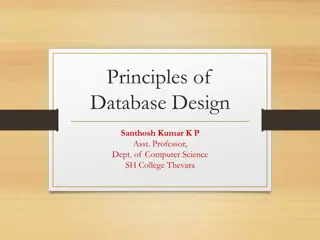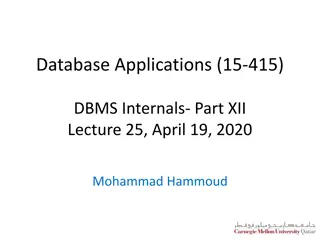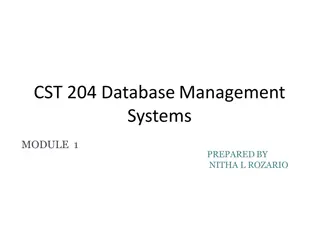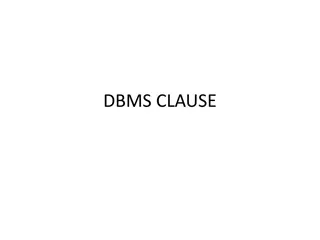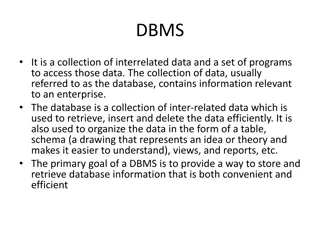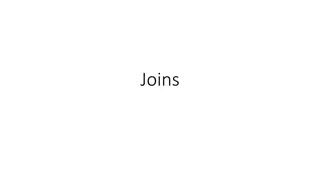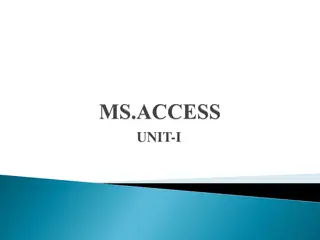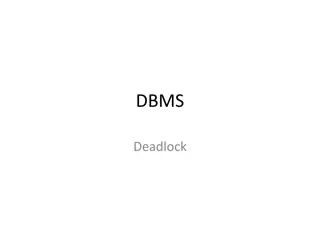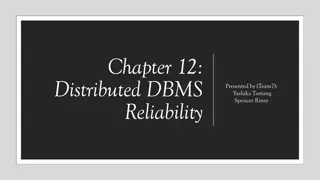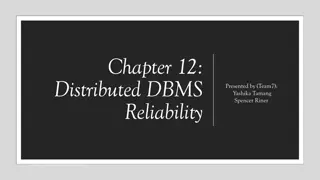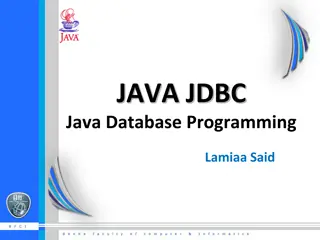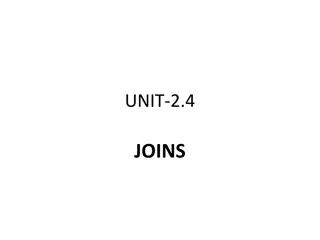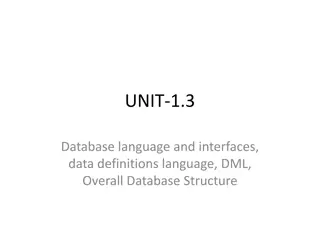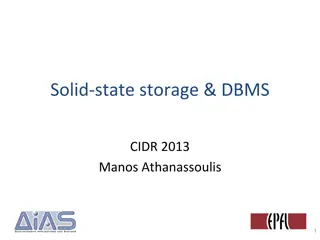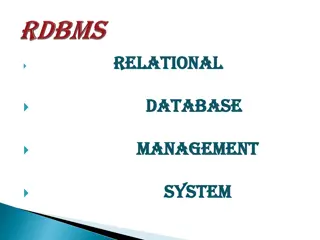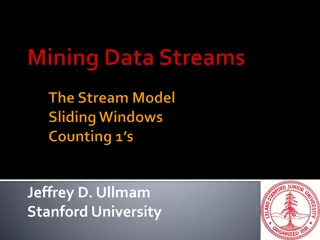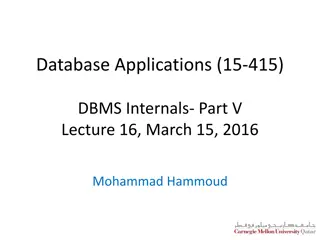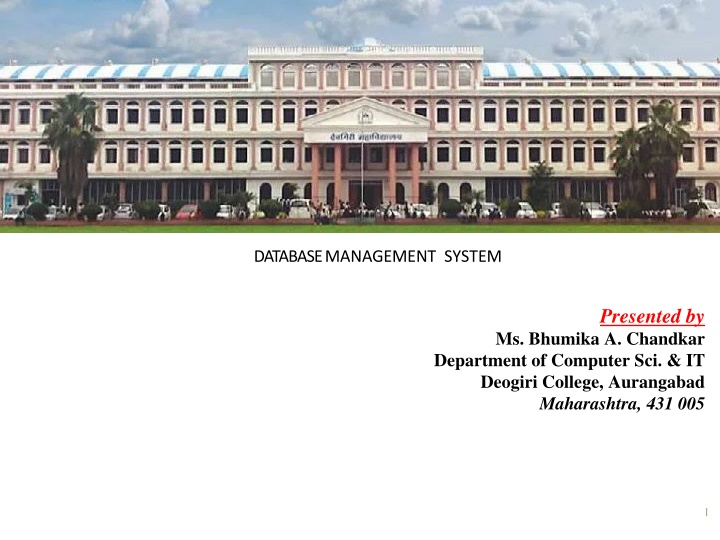
Introduction to Database Management Systems by Ms. Bhumika A. Chandkar
Explore the world of Database Management Systems (DBMS) through the insightful presentation by Ms. Bhumika A. Chandkar from Deogiri College, Aurangabad. Learn about the basics of DBMS, including its definition, components, and applications, along with examples of database mini-worlds and relationships. Discover the need for DBMS, types of databases, advantages, and disadvantages, in this comprehensive overview.
Uploaded on | 0 Views
Download Presentation

Please find below an Image/Link to download the presentation.
The content on the website is provided AS IS for your information and personal use only. It may not be sold, licensed, or shared on other websites without obtaining consent from the author. If you encounter any issues during the download, it is possible that the publisher has removed the file from their server.
You are allowed to download the files provided on this website for personal or commercial use, subject to the condition that they are used lawfully. All files are the property of their respective owners.
The content on the website is provided AS IS for your information and personal use only. It may not be sold, licensed, or shared on other websites without obtaining consent from the author.
E N D
Presentation Transcript
DATABASE MANAGEMENT SYSTEM Presented by Ms. Bhumika A. Chandkar Department of Computer Sci. & IT Deogiri College, Aurangabad Maharashtra, 431 005 1
|| Shri Hari || AN OVERVIEW OF DATABASE MANAGEMENT SYSTEM (DBMS) Introduction Prof Bhumika Chandkar
What is a DBMS? 2 A large, integrated collection ofdata Models a real-world enterprise Entities (e.g., Students, Courses) Relationships (e.g., Alice is enrolled in 145) A Database Management System (DBMS) is a piece of software designed to store and manage databases
Simplified database system environment
What you will learn in this Lecture Overview of DBMS Need for DBMS Types of Databases Components of DBMS Application of DBMS Advantages of DBMS Disadvantages of DBMS Prof Bhumika Chandkar
Basic Definitions Data are raw facts -It must be formatted for storage, processing, and presentation. Database collection of logically interrelated data Database Management -the creation & maintenance of a collection of organized data. Database Management System (DBMS) - It is a software package designed to define, manipulate, retrieve and manage data in a database. Prof Bhumika Chandkar
Example of a Database Mini-world for the example: Part of a UNIVERSITY environment. Some mini-world entities: STUDENTs COURSEs SECTIONs (of COURSEs) (academic) DEPARTMENTs INSTRUCTORs Prof Bhumika Chandkar
Example of a Database (contd.) Some mini-world relationships: SECTIONs are of specific COURSEs STUDENTs take SECTIONs COURSEs have prerequisite COURSEs INSTRUCTORs teach SECTIONs COURSEs are offered by DEPARTMENTs STUDENTs major in DEPARTMENTs Note: The above entities and relationships are typically expressed in a conceptual data model, such as the ENTITY-RELATIONSHIP data model Prof Bhumika Chandkar
Example of a simplified database catalog
Need for DBMS Provide a highly efficient method for handling large amount of different types of data with ease. Database allows data to be stored systematically. Data can be easily retrieved, filtered, sorted and updated efficiently and accurately. Prof Bhumika Chandkar
Types of Databases 1. Centralized Database: Prof Bhumika Chandkar
Based on Database location(s) 2. Distributed Database: Prof Bhumika Chandkar
Components of DBMS 1. Database Users 2. Data 3. Software and Procedures 4. Hardware 5. Database AccessLanguage Prof Bhumika Chandkar
Prof Bhumika Chandkar
1. Database Users End-users: They use the data for queries, reports and some of them update the database content. End-users can be categorized into: Sophisticated: These include business analysts, scientists, engineers, others thoroughly familiar with the system capabilities. Naive or Parametric: They use previously well-defined functions against the database. Examples are bank-tellers or reservation clerks who do this activity for an entire shift of operations using standard types of queries. Prof Bhumika Chandkar
Database Users (contd.) Database administrators: Responsible for authorizing access to the database, for coordinating and monitoring its use, acquiring software and hardware resources, controlling its use and monitoring efficiency of operations. Application programmers(Software Engineers): Responsible for writing database application programs in some programming language. Prof Bhumika Chandkar
2. Data The collection of facts stored in the database data is stored, updated and retrievedto from a database. Database contains both operational data and metadata. Prof Bhumika Chandkar
3. Software Operating System software DBMS software Network Software Application Programs and utility software Procedures: instructions and rules that govern the design and use of the database system. Prof Bhumika Chandkar
4. Hardware PC Network of computers Various Storage devices Input devices Output Devices Prof Bhumika Chandkar
5. Database Languages Data Definition Language (DDL) Create, Alter, Drop Data Manipulation Language (DML) Insert, Select, Update, Delete Data Control Language (DCL) Grant, Revoke Transaction Control Language (TCL) Commit, Rollback. Prof Bhumika Chandkar
Application of DBMS Banking Credit and Transactions Airline Sales Universities Human resourc e Presented By ShikhaGautam
Application of DBMS (contd.) TraditionalApplications: Numeric and Textual Databases More Recent Applications: Multimedia Databases Geographic Information Systems (GIS) Data Warehouses Real-time and Active Databases Many other applications Prof Bhumika Chandkar
Advantages of Using the Database Approach Controlling redundancy in data storage and in development and maintenance efforts. Sharing of data among multiple users. Restricting unauthorized access to data. Providing Storage Structures (e.g. indexes) for efficient Query Processing. Providing backup and recovery services. Providing multiple interfaces to different classes of users. Representing complex relationships among data. Enforcing integrity constraints on the database. Prof Bhumika Chandkar
When not to use a DBMS If the database and applications are simple, well defined, and not expected to change. High initial investment and possible need for additional hardware. Overhead for providing generality, security, concurrency control, recovery, and integrity functions. If access to data by multiple users is not required. Prof Bhumika Chandkar
What are the current ?? trends Multimedia Databases Distributed Database Document-oriented Databases Mobile & embedded Databases Prof Bhumika Chandkar

